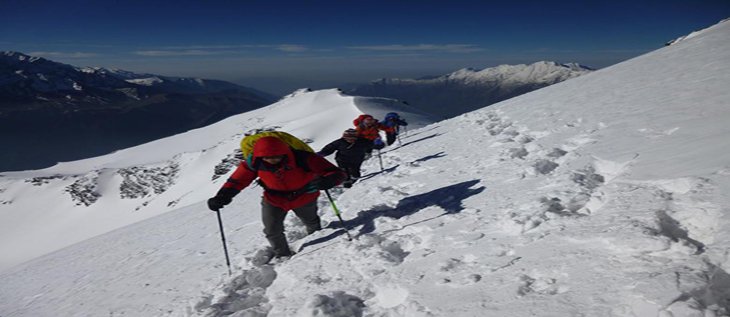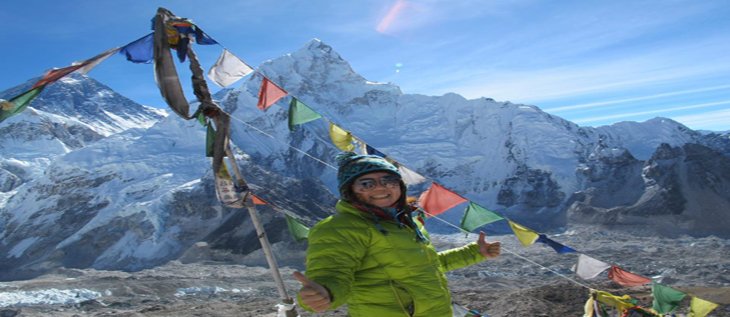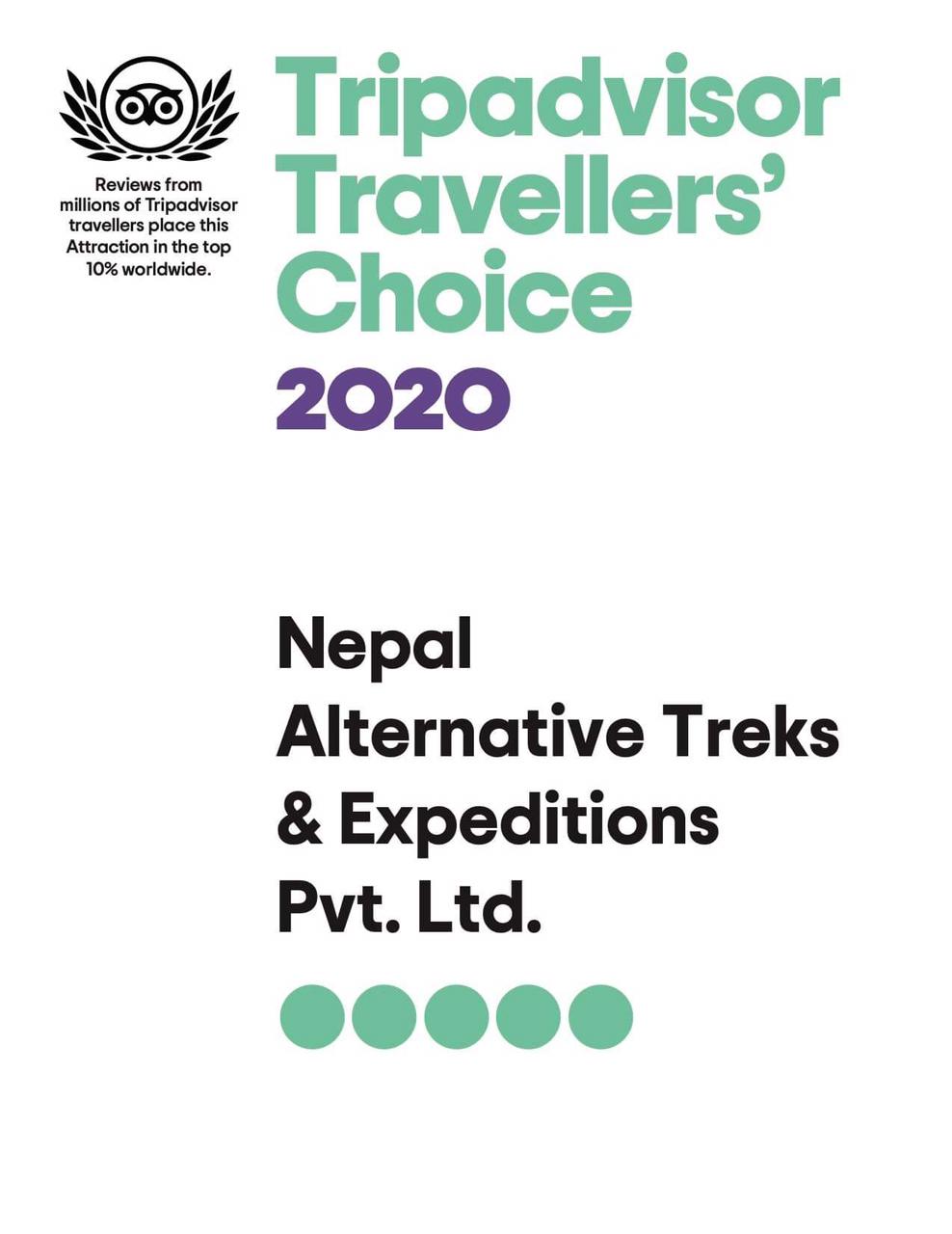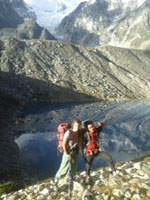Suggested Itinerary
Day 1: Fly to Lukla, trek to Paiya (Chutok) (2,730m/8,956ft): 40 mins flight, 5-6 hours trek
We catch an early morning flight to Lukla and begin our trek to Paiya after landing at the Tenzing-Hillary airport in Lukla. We walk on a jungle trail, cross a bridge over the Handi Khola and reach Surke Village. From here we continue moving south and cross the Chutok La pass before reaching the small settlement of Paiyan, also known as Chutok. Overnight in Paiya.
Included meals: Breakfast, Lunch, Dinner
Day 2: Paiya to Panggom (2,846m/9,337ft): 5-6 hours walk
We descend for a while and reach a small bridge. From here the trail is slippery until we cross the Kari La pass. We walk through rhododendron and bamboo forests on a narrow mountain trail. On today’s trip we also get to be in awe of the Dudhkoshi Valley. We continue our trek to Panggom Village whose settlers are dependent on farming and trading. Overnight in Panggom.
Included meals: Breakfast Lunch Dinner
Day 3: Panggom to Ningsow (2,863m/9,393ft): 4-5 hours walk
We begin our trek after breakfast. After trekking out of Panggom, we cross the Panggom La pass. Then we ascend, walk on a steady path and turn north. We cross Peseng Kharka Khola first then after walking for sometime, reach Peeng Kharka Danda. We cross Ningsow Khola (stream) before reaching the Ningsow Village. Overnight in Ningsow.
Included meals: Breakfast, Lunch, Dinner
Day 4: Ningsow to Chhatra Khola (2,800m/9,186ft): 7-8 hours walk
From Ningsow, we climb first then descend for a while and climb some more to reach Ramailo Danda. From here we get extraordinary views of Mera Peak and Salpa. After ascending and descending on our trail, we enter the Makalu Barun National Park. Our trail from here to Chhatra Khola is called Pasang Lhamu trail. On the way, if we are lucky, we might even come across the elusive Red Panda. Overnight in Chhatra Khola.
Included meals: Breakfast Lunch Dinner
Day 5: Chhatra Khola to Kothe (3,691m/12,109ft): 6-7 hours walk
We walk towards the north on the main trail to Mera Peak. After walking on a trail next to the the Majang Khola, we merge with another trail which moves alongside the Hinku Khola. Our trail moves straight ahead towards Tashing Ongma which has seasonal tea shops. We continue our trek and cross the bridge over the Sanu Khola before reaching Kothe. Overnight in Kothe.
Included meals: Breakfast Lunch Dinner
Day 6: Kothe to Thaknak (4,358m/14,297ft): 3-4 hours walk
We trek along the ridge of the Hinku Khola in the shadow of Mera Peak. We take lunch at Gondishung, the summer herders' settlement in the west bank of the Hinku Drangka. Beyond Gondishung, we pass a 200-year-old Lungsumgba Gompa where we can find Mera Peak scripted in rock along with its route to reach Mera. A short walk takes us to Thaknak, which is a summer grazing area with primitive lodges and shops. Overnight in Thaknak.
Included meals: Breakfast Lunch Dinner
Day 7: Thaknak to Khare (5,045m/16,486ft): 2-3 hours walk
Leaving Thaknak, we follow the lateral moraine of Dig Glacier to Dig Kharka, which offers spectacular views of Charpate Himal. The trail climbs through moraines to the snout of the Hinku Nup and Shar glaciers, and then climbs more steeply to Khare. From here, we can see the northern face of Mera Peak which will be an amazing experience. After lunch we can hike in and around Khare. Overnight at Khare.
Included meals: Breakfast Lunch Dinner
Day 8: Khare: Acclimatization and pre–climb training
We have a separate day set aside solely for acclimatization and basic training just to prepare ourselves better for the Mera Peak climb. Our climbing leader will help us polish our basic climbing techniques and demonstrate the best ways to use our climbing gears like the ice axe, harness, ascender climbing boots and crampons. The training will also include learning the best technique to use the rope for climbing up and down. Overnight in Khare.
Included meals: Breakfast Lunch Dinner
Day 9: Khare to Mera High Camp (5,780m/18,958ft): 6-7 hours walk
We walk through a boulder-strewn course on a steep trail to reach the Mera Peak Base Camp. From here, we continue further through the Mera La pass to reach the Mera High Camp. Our path is along a rocky trail, which can be hazardous if it has recently snowed, as there are a number of crevasses here. We make our way to the top of the rock band, which is marked by a large cairn. Then set up a high camp while enjoying excellent views of Mt. Everest, Makalu, Cho Oyu, the south face of Lhotse, Nuptse, Chamlang and Baruntse. Overnight at Mera High Camp.
Included meals: Breakfast Lunch Dinner
Day 10: Summit Mera Peak (6,461m/21,190ft), trek to Kongma Dingma (4,850m/15912ft):10-11 hours
We wake up around 2 in the morning for breakfast. It’s going to be very cold in the beginning but we get warmer as we continue up the glacier and onto a peculiar ridge. The first rays of the sun hit the big peaks in an amazing red glow. The route is still non-technical as we slowly climb higher into the ever-thinning air. The slope steepens for a section behind the ridge and the summit comes back into view. At the foot of the final steep summit cone, we may attach to a fixed rope depending on the conditions. The summit is only a few meters away. From the summit, we take in amazing views of the mighty Himalayas including Mt. Everest (8,848m), Cho-Oyu (8,210m), Lhotse (8,516m), Makalu (8,463m), Kanchenjunga (8,586m), Nuptse (7,855m), Chamlang (7,319m), Baruntse (7 ,129m) and others. Later, we retrace our steps back to the high camp where we rest for a while before descending to Kongma Dingma. Overnight in Kongma Dingma
Included meals: Breakfast Lunch Dinner
Day 11: Kongma Dingma: rest day
We take the much needed rest in Kongma Dingma today.
Included meals: Breakfast Lunch Dinner
Day 12: Contingency
There is no guarantee that we will have favorable weather on our planned day for the summit. Therefore, this day is set aside as a contingency in case we are unable to summit the Mera on day 12 due to bad weather conditions or any other unanticipated reason.
Included meals: Breakfast Lunch Dinner
Day 13: Kongma Dingma to Seto Pokhari (5035m/16519 ft): 5-6 hours walk
We head up into the upper yak pastures of this incredible remote valley. All morning the great flanks of Chamlang dominate our left, and the spire of Baruntse comes into view beyond. The terrain is remarkably benign, especially considering we are actually heading directly into the very epicenter of the highest group of mountains in the world. The valley floor remains broad and straight, only gradually rising to the blind alley of peaks ahead. It is almost a shock to realize that the two majestic mountains we are heading straight towards are none other than Everest and Lhotse. Overnight in camp at Seto Pokhari.
Included meals: Breakfast Lunch Dinner
Day 14: Seto Pokhari to Amphu Labcha Base Camp (South) (5,650m/18,536 ft): 5-6 hours walk
This is one of the remotest parts of the Himalayas, so we rarely see any trekkers en-route except if it is a very high tourist season. From Seto Pokhari we move ahead and pass through several lakes that occupy the upper Hunku Basin. After walking past Hunku Pokhari, our trail is next to the magnificent Hunku Glacier. We continue further with another lake close by to our trail. Overnight in Amphu Labcha Base Camp.
Included meals: Breakfast Lunch Dinner
Day 15: Amphu Labcha Base Camp to Chhukung (4,750m/15,580 ft): 9-10 hours walk
We cross the Amphu Labcha La pass (5,845m) then walk across the Amphu Labcha Glacier. Lhotse Shar Glacier and Imja Glacier are nearby. Our trail also half circles the Imja Tsho lake before walking on the main Island Peak trail. Moving further ahead, we are also in the vicinity of the Ama Dablam Glacier before reaching Chhukung. Overnight in Chhukung.
Included meals: Breakfast Lunch Dinner
Day 16: Chhukung to Namche Bazaar (3,438m/11,280 ft): 5-6 hours walk
We begin our descent to Namche Bazaar after breakfast. We reach a sparse settlement of Bibre and cross a bridge over the Imja Khola. Our trail passes through beautiful villages, grasslands and cross several bridges before reaching Namche Bazaar. There is an amazing view point a little further from our trail at Dingboche. Overnight in Namche Bazaar.
Included meals: Breakfast Lunch Dinner
Day 17: Namche Bazaar to Lukla (2,800m/9,184ft): 6-7 hours walk
We begin our trek to Namche Bazaar today on a rocky terrain. It is mostly a downhill trek on a trail alongside the Dudh Koshi River. We cross several suspension bridges, pass by several monasteries and villages before reaching Lukla. After reaching Lukla we spend the rest of the day taking a rest as today will be our last day on the mountains. Overnight in Lukla.
Included meals: Breakfast Lunch Dinner
Day 18: Fly back to Kathmandu ( 35 minutes) flight
The flights to Kathmandu are usually scheduled for morning due to safety reasons. After reaching the capital city, we have the rest of the day off to past the time as we please. We could take a rest in our hotel room or shop for souvenirs for our loved ones. In the evening, there will be a farewell dinner to celebrate the successful completion of our Mera Peak Climbing and Amphu Labcha Pass. Overnight in Kathmandu.
Included meals: Breakfast
Trip Ends










 Quick Inquiry
Quick Inquiry


















